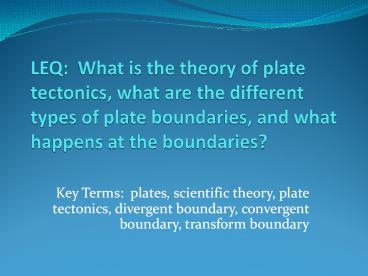LEQ: What is the theory of plate tectonics, what are the different types of plate boundaries, and what happens at the boundaries? - PowerPoint PPT Presentation
Title:
LEQ: What is the theory of plate tectonics, what are the different types of plate boundaries, and what happens at the boundaries?
Description:
Key Terms: plates, scientific theory, plate tectonics, divergent boundary, convergent boundary, transform boundary * * Earth s Lithospheric Plates Turn to page 86 ... – PowerPoint PPT presentation
Number of Views:313
Avg rating:3.0/5.0
Title: LEQ: What is the theory of plate tectonics, what are the different types of plate boundaries, and what happens at the boundaries?
1
LEQ What is the theory of plate tectonics, what
are the different types of plate boundaries, and
what happens at the boundaries?
- Key Terms plates, scientific theory, plate
tectonics, divergent boundary, convergent
boundary, transform boundary
2
Earths Lithospheric Plates
- Turn to page 86 in your textbook.
- Proposed by Canadian Geoscientist J. Tuzo Wilson
- Earths lithosphere is not one large unbroken
layer. - Earths lithosphere is more like the cracked
shell of a hard boiled egg. - Each broken piece is known as a plate.
- Each plate is named.
- Plates are separated by jagged edges that form
boundaries between the plates. - The jagged edges are known as plate boundaries.
3
What does it look like?
4
Scientific Theory
- A scientific concept that
- Must be well tested.
- Must explain a wide range of observations.
- Continued scientific evidence, testing, and
results support the theory. - Can change if new scientific evidence, testing,
and results do not support the theory.
5
The Scientific Theory of Plate Tectonics
- The theory of plate tectonics is the geological
theory which states that pieces of Earths
lithosphere are in constant, slow motion, driven
by convection currents in the mantle. - It is a well tested scientific concept that
explains the - Formation of Earths Plates
- The movement of Earths Plates
- Subduction of Earths Plates
6
Plate Boundaries
- The jagged edges that separate Earths
lithospheric plates. - Extend deep into the lithosphere.
- Plates move past each other along the boundaries.
- Three different types of plate movement occur at
boundaries. - Each type is classified according to the how the
plates move past each other at the boundary. - Divergent Boundaries
- Convergent Boundaries
- Transform Boundaries
7
Divergent Plate Boundaries
- Turn to page 89.
- Plates move apart from each other or diverge.
- Most divergent boundaries occur at the mid-ocean
ridge where sea floor spreading is occurring. - Also develop on land when a continental plate
pulls apart. - Rift Valley
8
Convergent Plate Boundaries
- Turn to page 90.
- Plates come together or converge.
- Collisions occur.
9
Convergent Boundary Collisions
- Collisions bring together
- Oceanic Crust and Oceanic Crust
- Oceanic Crust and Continental Crust
- Continental Crust and Continental Crust
- When plates collide, the density of the plates
will determine what occurs. - The more dense plate will subduct below the less
dense plate.
10
Converging Plates both carrying Oceanic Crust
- A plate boundary where one plate with oceanic
crust collides with another plate with oceanic
crust. - When the plates collide, the more dense crust is
subducted through a trench and sinks toward the
mantle. - As it sinks, the rock melts forming molten
material. The molten material then either sinks
back into the mantle, or works its way to the
surface creating new volcanic landforms. - Volcanic islands (ex. Japan) and Island Arcs (ex.
The Philippines) are formed on the floating
plate.
11
Converging plates one with Oceanic Crust and the
other with Continental Crust
- A plate boundary where a plate carrying oceanic
crust collides with a plate carrying continental
crust. - When the plates collide, the plate carrying the
oceanic crust (because it is more dense) is
subducted through a trench and sinks toward the
mantle. - As it sinks, the rock melts forming molten
material. The molten material then either sinks
back into the mantle, or works its way to the
surface creating new volcanic landforms. - The plate carrying the continental crust buckles
and mountain ranges (ex. The Andes and Cascades)
form along the coast. Continental Volcanic Arcs
also form on the plate carrying the continental
crust.
12
Converging Plates both carrying Continental Crust
- A plate boundary where one plate carrying
continental crust collides with another plate
carrying continental crust. - Continental crust has the same density.
- Neither plate sinks, but the plates buckle and
form mountain ranges (ex. The Himalayas)
13
Transform Boundaries
- Turn to pages 91.
- Two plates move along the boundary slipping and
sliding past each other. - Crust is neither created nor destroyed.
14
Lets go back to the our map to see where the
different types of plate boundaries are located.
15
AssignmentUse your textbook or other resources
- Complete the graphic organizers of the three
types of plate boundaries. - When complete, do the map activity on the other
side of the handout. - Use 3 different colored pencils to create a map
key. - Find the plate boundaries on the map.
- Research what type of plate boundary exists at
each plate boundary. - Use your map key and trace over each plate
boundary with the color for the type of boundary
that exists at that location. - The following link courtesy of Teachers Domain
may help - Plate Tectonics and Boundaries
16
On line Activity
- Turn in your assignment when complete.
- After turning in your worksheet, do the online
- Plate Interactions Challenge.































